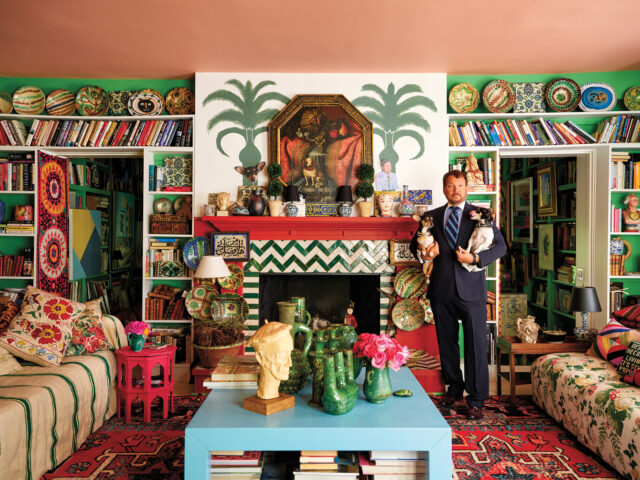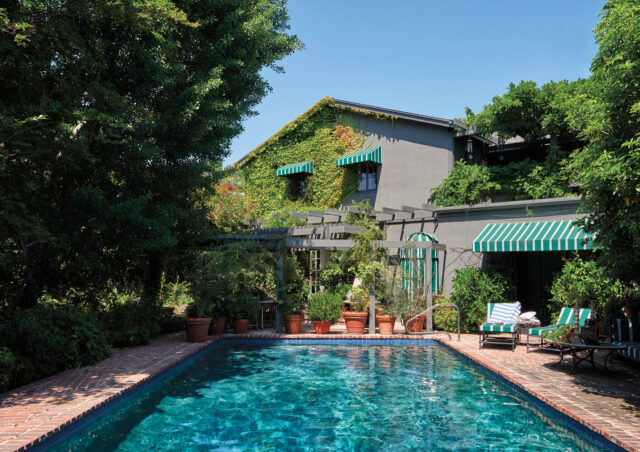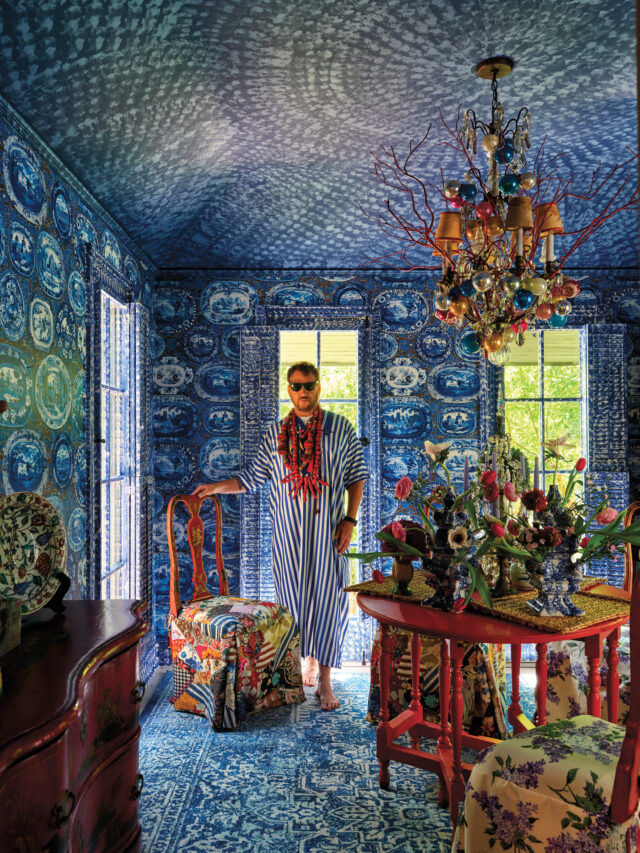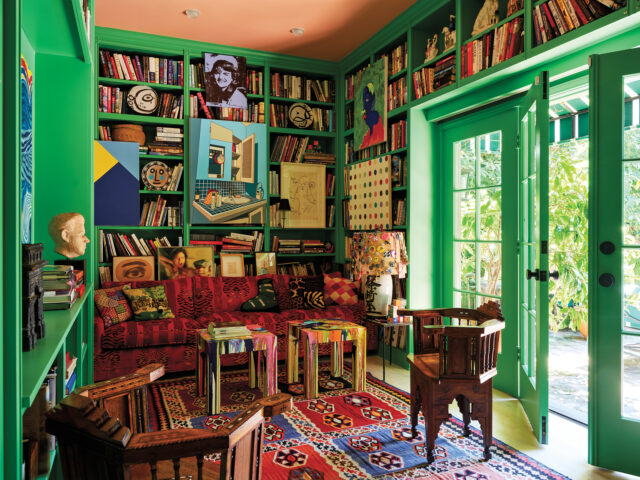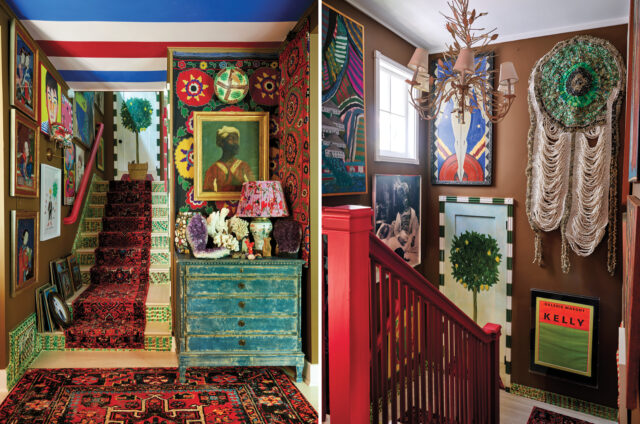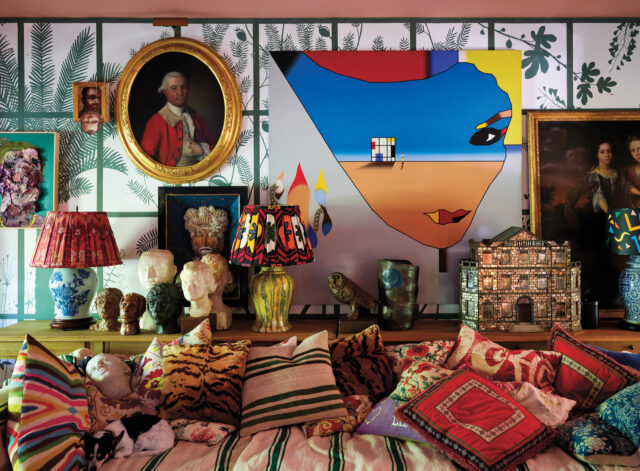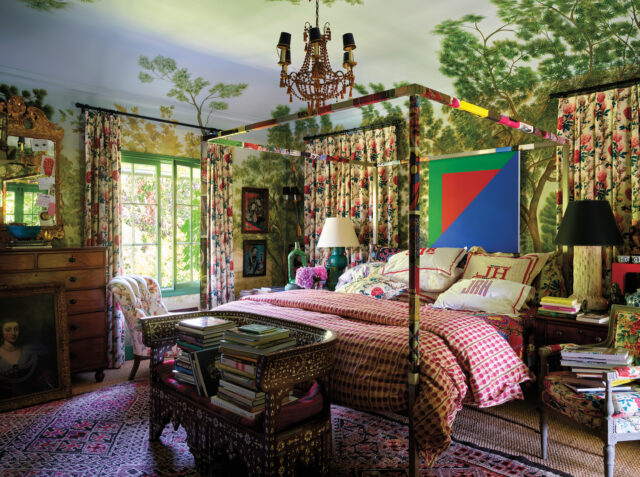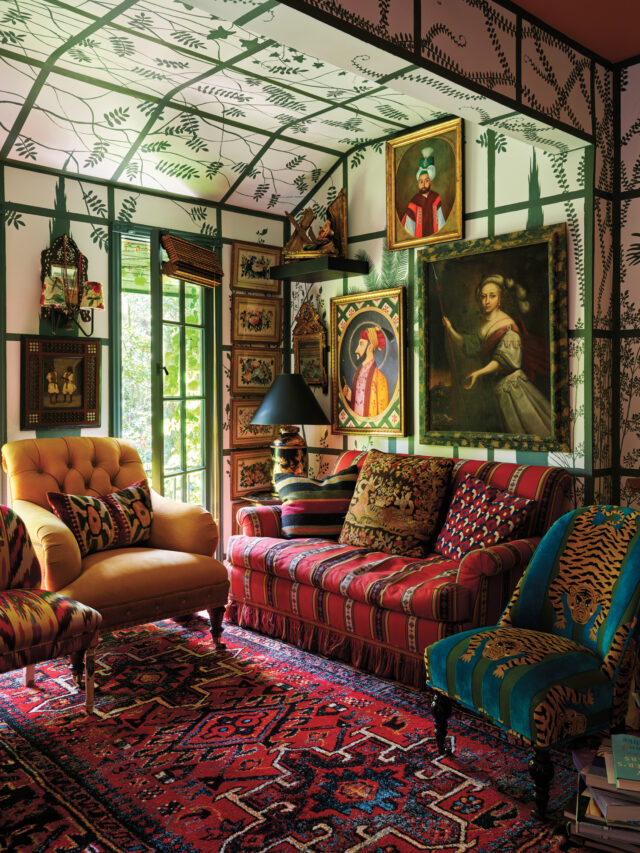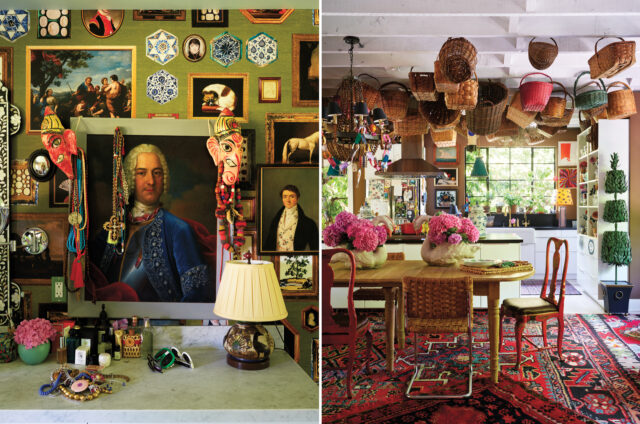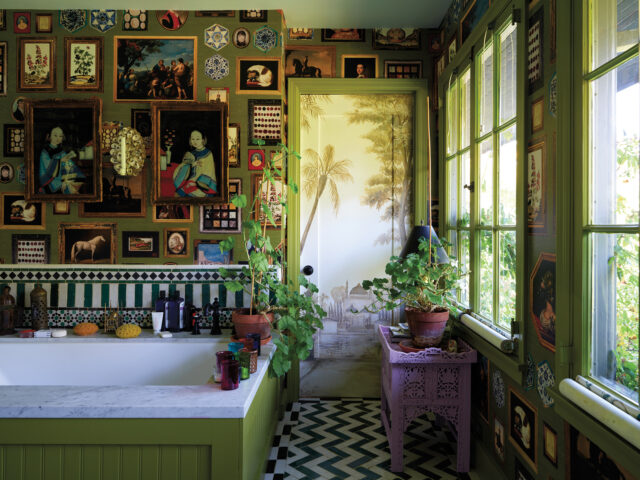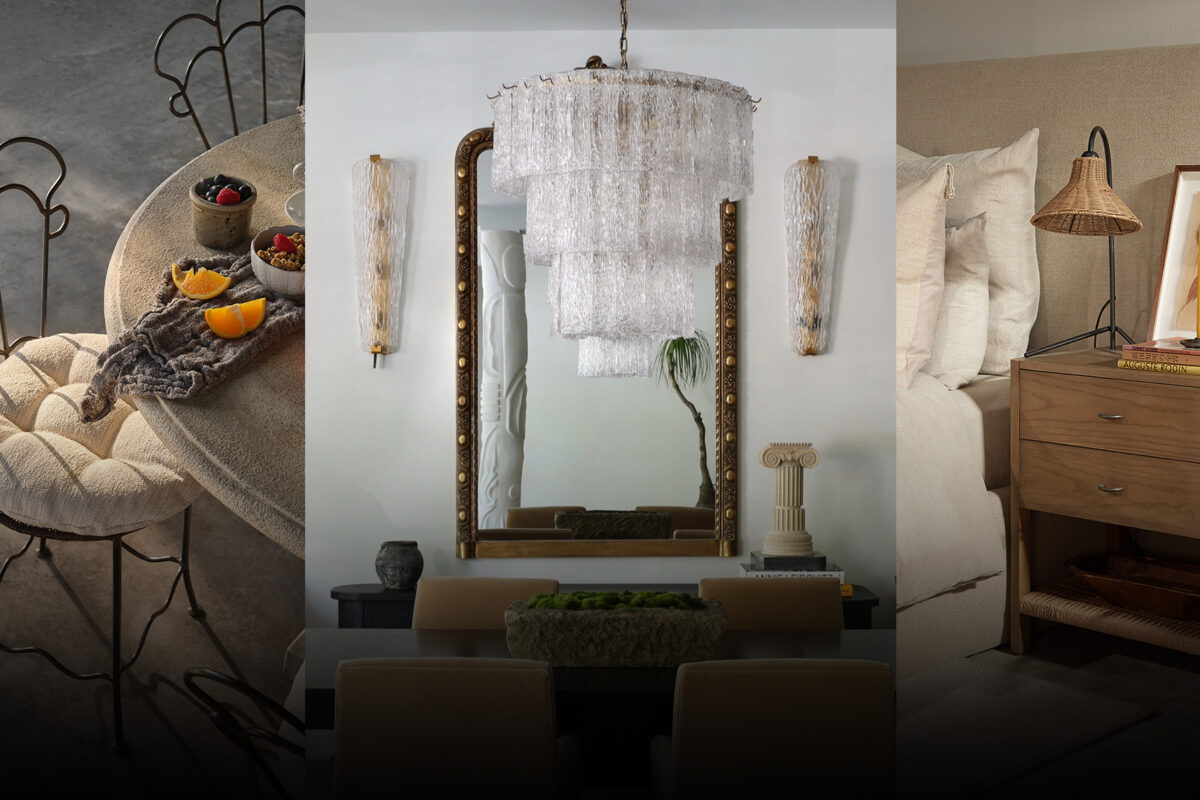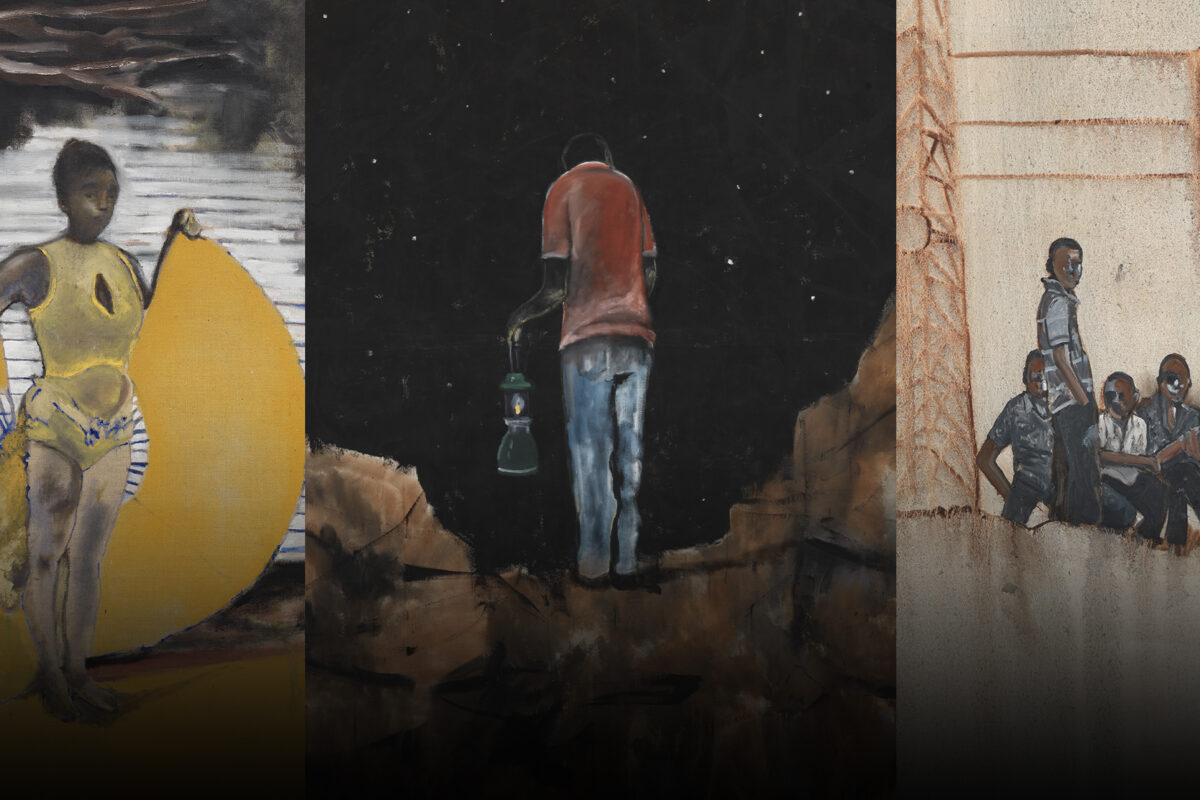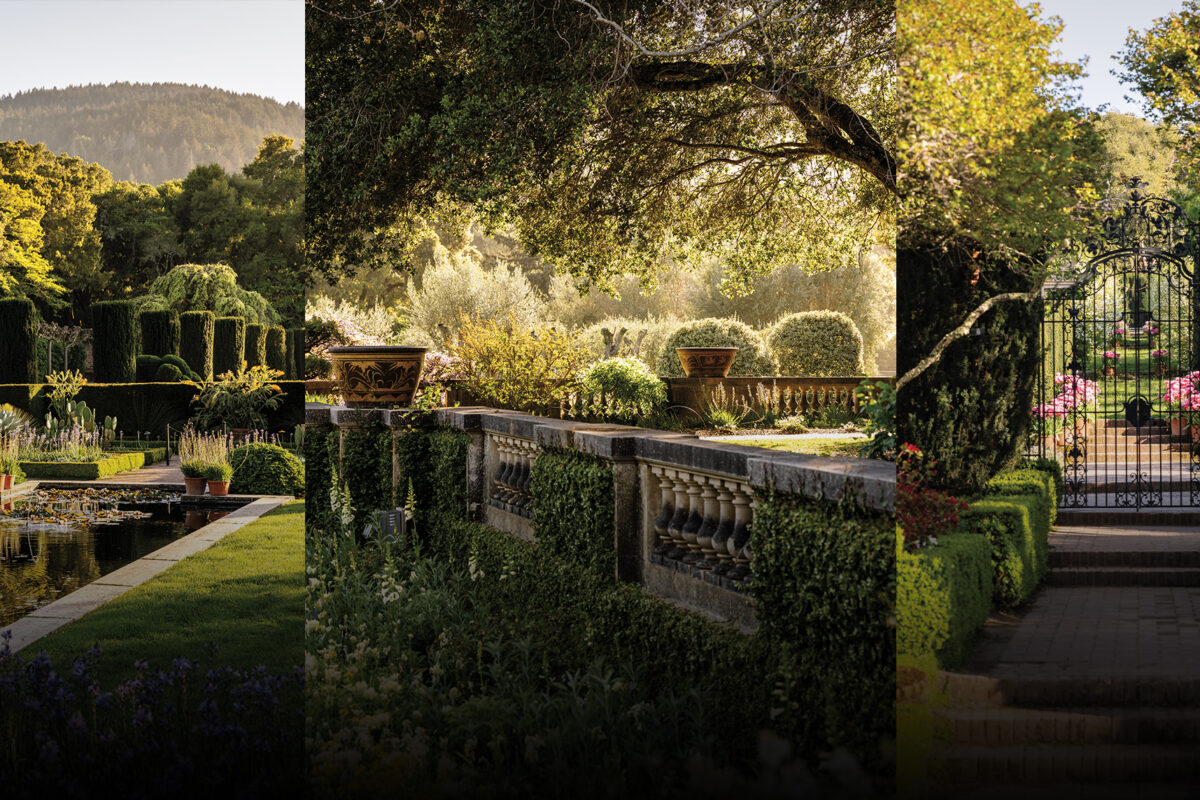Designer Johnson Hartig has fashioned his Windsor Square home around a trove of art and objets amassed over a lifetime of travel and treasure hunting
Photography by ROGER DAVIES
Words by KELSEY McKINNON
A cheery mashup of English, Moroccan, and Nantucket influences in the living room, where Johnson Hartig (holding his rescue dogs, Flower and Radish) spends the most time. He removed the original crown molding, installed bookcases, and raised the fireplace off the ground so it would be more visible.
At the top of the staircase in Johnson Hartig’s home is a massive encasement of nine kaleidoscopic spin art pieces that are unmistakably the handiwork of famed British artist Damien Hirst. “Actually, Damien and I painted these together in his studio in London,” says Hartig, the visionary designer behind the luxury fashion line Libertine, who paid a visit to Hirst’s studio while he was on a trip studying English country homes in Yorkshire. The pair struck up a friendship more than a decade ago and traded clothing for artwork for many years. “I think we both are able to take these simple ideas and make them into gorgeous things,” says Hartig, who has nine major pieces from Hirst scattered throughout his home and studio in Hollywood.
Hirst isn’t Libertine’s only A-list admirer or collaborator. Hartig’s iconoclastic collections have earned him an ardent following among the upper echelons of the world’s creative cognoscenti — from the late Karl Lagerfeld, who was a client and who first championed that Libertine be inducted into the Council of Fashion Designers of America, to Martha Stewart, Taylor Swift, and Brad Pitt. Different as they may be, Hartig’s army of cheerful Libertines share an affection for Hartig’s maximalist wonderland, where supremely tailored pieces in riotous colorways and patterns are dusted with glitter, adorned with hand-sewn appliqués, and collected like works of art themselves.
“In many respects, a white space equals a blank mind”
JOHNSON HARTIG
A view of the vine-covered home from the backyard.
A block off Larchmont Boulevard on a quiet tree-lined street in the Windsor Square historic district, Hartig’s home is an intoxicating showcase of his disparate collections: nautical dioramas (of which he thinks he has the largest in North America), Mario Buatta dog portraits, blue-and-white ginger jars, Islamic pottery, Persian rugs, books, art, and vintage wicker baskets (so many hang from the rafters in the kitchen that Hartig named the home Basket Case). “If you are curious about the world and have passions about things, why is that not reflected in your most intimate space?” he asks. “I feel like a white space equals a blank mind in many respects.”
Hartig purchased the 101-year old property just before the start of the global pandemic, when he was looking for a new project with more space and a garden. It is almost hidden from the street thanks to a small forest Hartig planted in the yard, which includes milkweed to attract butterflies, jersey vine that climbs up the dark gray stucco walls, and a kitchen garden where he grows everything from blueberries to artichokes. He shares the home with his “girls”: two rescue puppies, Flower and Radish, whom he is constantly scolding in the most lighthearted way: “Girls! Girls! This is out of control. I worked so hard ironing these pillows. Girls, girls! Off the sofa. How rude. You girls are so bad.”
The home’s proximity to the Libertine studio, where he has a 20-person team, was important. Hartig typically wakes up at 4:30 a.m. and is at the office by 6. He has a very early lunch at 9:30 a.m., returns home to take a nap at 10, and goes back to the studio until around 4. When he comes home from work, he goes for a long walk (around 10,000 steps), then settles into the couch to scour online auctions.
“We are able to take simple ideas and make them into gorgeous things”
JOHNSON HARTIG
The dining room features Hartig’s Plates and Platters wallpaper for Schumacher; Hartig sponge-painted the ceiling to create a grotto effect. The chairs are slipcovered in Libertine’s Proust’s Lilacs and Hotch Potch Crazy Quilt fabrics for Schumacher.
Hartig admits he wins something on the digital chopping block almost every single day. “I think it’s at the point where I might need to have my own auction because I have a guest house filled with stuff,” he says. Whether its Syrian enamel or an 18th-century Dutch painting, Hartig’s proclivity for worldly artifacts may be due to the fact that he had traveled around the globe by the time he was a teenager. His father was an engineer with a construction company that built oil refineries, and the Hartig family lived in Alaska, Saudi Arabia, and Indonesia before they ended up in Whittier, where Hartig was born.
The vibrant pink-and-red Tibetan-inspired tiger printed sofa, however, was a product of his own making. Several years ago, Schumacher asked Hartig to design a line of wallpapers and fabrics. He recently finished his third collection for the house and has at least two more in the pipeline. His Jokhang tiger print is one of Schumacher’s most successful collaborations to date.
With many prints culled from the Libertine archives, there is a common thread between Hartig’s fashion and furnishings. Today Hartig putters about in frayed shorts in a modernized trompe l’oeil pattern that coordinates with the dining room wallpaper; he originally conceived the print for Libertine before producing it with Schumacher for interiors.
“I have been known to paint a room three colors in one day”
JOHNSON HARTIG
Similarly, a lilac suit hanging in the closet is the same pattern that adorns two occasional chairs downstairs. One day Hartig imagines venturing into furniture, rugs, bedwear, and tabletop design, but in the meantime, La Maison by Libertine offers everything from Chinese vases painted on dummy board to sequined skull pillows and English garden–inspired candles.
“The fact is, I don’t really consider myself a real fashion designer, but I’m interested in making beautiful things,” he says. Indeed, Hartig has always relied on a kind of boot-strapping creative ingenuity to manifest ideas. “I once tried to teach myself how to do faux marble and it was a disaster. Then I thought, ‘I bet I can sponge paint,’” he says, referring to the dining room ceiling and the staircase. A linchpin of Hartig’s creative process is a highly forgiving system of trial and error. “I have been known to paint a room three different colors in one day. That’s why my painters absolutely love me,” he says with a laugh. “But the lesson is that nothing is totally sacred; nothing is irreversible. I just go for it.”
The vibrant green library boasts two coffee tables from West Elm that Hartig painted over, a sofa clad in his Jokhang tiger print, and a Damien Hirst dot painting.
LEFT: The entry features an array of suzanis, pottery, and crystals. Hartig sponge-painted the stair risers to reflect the colors of his green-and-brown pottery collection. RIGHT: Artwork on the landing includes a portrait of Hartig shot by Autumn de Wilde.
Above the sofa in the living room, a piece by British painter Duggie Fields mingles with 18th-century oil portraits bought at auction, a miniature Georgian mansion from the 18th century made of mica, and colorful printed lampshades designed by Hartig.
Schumacher’s Italian Panoramic wallcovering graces the master bedroom; a local muralist continued the scene on the ceiling. Hartig painted the abstract work centered in the bed, the frame of which is adorned with cutouts from Gagosian Gallery magazine.
Hartig hired a local muralist to paint a Piero Castellini–inspired scene of California plants in the living room and adjacent seating area.
LEFT: In the main bathroom, Hartig’s Le Grand Tour wallpaper for Schumacher is layered with antique portraits and Indian masks. RIGHT: A collection of vintage baskets hangs above a metal topiary that originally belonged to Gloria Vanderbilt.
The master bath plays off Hartig’s green Le Grand Tour wallcovering above the tub, which he layered with more paintings. He selected each Zellige tile and commissioned the Moroccan-style scene on the door.
Feature image: Hartig in the garden sporting a jacket in Libertine’s Fernie print from the spring collection.
This story originally appeared in the Fall 2023 issue of C Magazine.
Discover more STYLE news.
See the story in our digital edition

